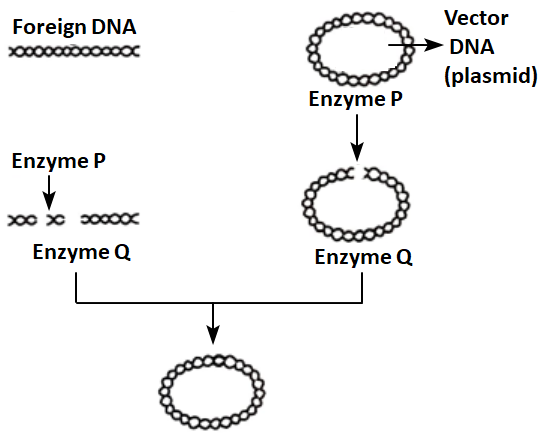Select Question Set:
Assertion(A): Synthetic oligonucleotide polymers are used during Annealing in a PCR
Reason(R): The primers bind to the double stranded DNA at their complementary regions
1.
Both (A) and (R) are true and (R) is the correct explanation of (A)
2.
Both (A) and (R) are true, but (R) is not the correct explanation of (A)
3.
(A) is true, but (R) is false
4.
(A) is false, but (R) is true
Subtopic: Polymerase Chain Reaction: PCR |
Level 3: 35%-60%
Please attempt this question first.
Hints
Please attempt this question first.
Match the process of PCR in column I with the corresponding temperature in column II and select the correct option
1. (a)-(ii), (b)-(i), (c)-(iii)
2. (a)-(i), (b)-(iii), (c)-(ii)
3. (a)-(i), (b)-(ii), (c)-(iii)
4. (a)-(ii), (b)-(iii), (c)-(i)
| Column-I | Column-II | ||
| (a) | Heat denaturation | (i) | 70-75°C |
| (b) | Annealing | (ii) | 90-98°C |
| (c) | Primer extension | (iii) | 40-60°C |
2. (a)-(i), (b)-(iii), (c)-(ii)
3. (a)-(i), (b)-(ii), (c)-(iii)
4. (a)-(ii), (b)-(iii), (c)-(i)
Subtopic: Polymerase Chain Reaction: PCR |
65%
Level 2: 60%+
Please attempt this question first.
Hints
Please attempt this question first.
Consider the given two statements:
| Assertion (A): | A piece of DNA, if needed to be propagated during recombinant DNA procedures, requires a vector. |
| Reason (R): | The vectors provide the origin of replication. |
| 1. | Both (A) and (R) are True but (R) does not correctly explain (A). |
| 2. | (A) is False but (R) is True. |
| 3. | (A) is True but (R) is False. |
| 4. | Both (A) and (R) are True and (R) correctly explains (A). |
Subtopic: Tools |
74%
Level 2: 60%+
Please attempt this question first.
Hints
Please attempt this question first.
Introduction of an alien DNA into plant host cell is achieved by making them
1. Competent with bivalent ions
2. Using microinjections
3. Using gene gun
4. Using lysozymes and chitinase
1. Competent with bivalent ions
2. Using microinjections
3. Using gene gun
4. Using lysozymes and chitinase
Subtopic: Transforming Plant & Animal Cell |
63%
Level 2: 60%+
Please attempt this question first.
Hints
Please attempt this question first.
The given picture is an example of:

1. Plasmid
2. Bacteriophage
3. Bacteria
4. Antibiotic

1. Plasmid
2. Bacteriophage
3. Bacteria
4. Antibiotic
Subtopic: Process of Biotech |
91%
Level 1: 80%+
Please attempt this question first.
Hints
Please attempt this question first.
Which of the following does not hold true for restriction enzymes?
| 1. | It recognises a palindromic nucleotide sequence. |
| 2. | It is an endonuclease. |
| 3. | It is isolated from viruses. |
| 4. | it can produce the same kind of sticky ends in different DNA molecules. |
Subtopic: Restriction Enzymes - Main Enzymes |
80%
Level 1: 80%+
Please attempt this question first.
Hints
Please attempt this question first.
Name the enzymes 'P' and 'Q' that are involved in the processes given below.


| 1. | Enzyme P-Exonuclease and Enzyme Q-permease. |
| 2. | Enzyme P-Exonuclease and Enzyme Q-Ligase. |
| 3. | Enzyme P-Endonuclease and Enzyme Q-permease. |
| 4. | Enzyme P-Restriction endonuclease and Enzyme Q-Ligase. |
Subtopic: Restriction Enzymes - Main Enzymes |
80%
Level 1: 80%+
Please attempt this question first.
Hints
Please attempt this question first.
| Assertion (A): | During the heat shock method, the cells are incubated with recombinant DNA at \(42^{\circ} \mathrm{C}\), following by placing them briefly on ice and then putting if back at \(42^{\circ} \mathrm{C}\). |
| Reason (R): | After heat shock, uptake of DNA through transient pores in the bacterial cell wall takes place. |
| 1. | Both (A) and (R) are true and (R) is the correct explanation of (A). |
| 2. | Both (A) and (R) are true but (R) is not the correct explanation of (A). |
| 3. | (A) is true but (R) is false. |
| 4. | (A) is false but (R) is true. |
Subtopic: Transforming Plant & Animal Cell |
Level 3: 35%-60%
Please attempt this question first.
Hints
Please attempt this question first.
If an enzyme catalyzes the removal of nucleotides from the ends of DNA, it will be called as a/an:
1. endonuclease
2. exonuclease
3. DNA ligase
4. DNA polymerase
1. endonuclease
2. exonuclease
3. DNA ligase
4. DNA polymerase
Subtopic: Restriction Enzymes - Main Enzymes |
90%
Level 1: 80%+
Please attempt this question first.
Hints
Please attempt this question first.
Consider the given two statements:
| Assertion (A): | The most commonly used bioreactors for biosynthesis are of stirring type. |
| Reason (R): | A bioreactor provides the optimal conditions for achieving the desired product by providing optimum growth conditions. |
| 1. | Both (A) and (R) are True and (R) correctly explains (A). |
| 2. | (A) is True; (R) is False |
| 3. | (A) is False; (R) is False |
| 4. | Both (A) and (R) are True but (R) does not correctly explain (A). |
Subtopic: Bioreactors/Downstream Processing |
56%
Level 3: 35%-60%
Please attempt this question first.
Hints
Please attempt this question first.
Select Question Set:






